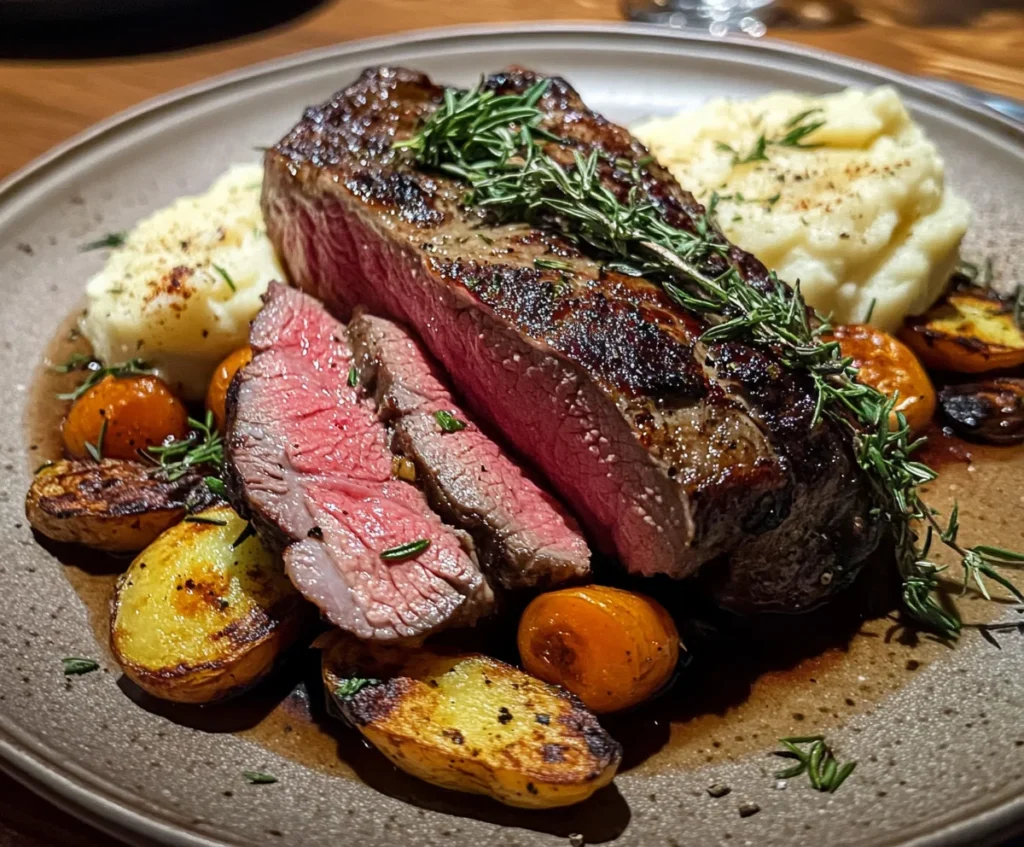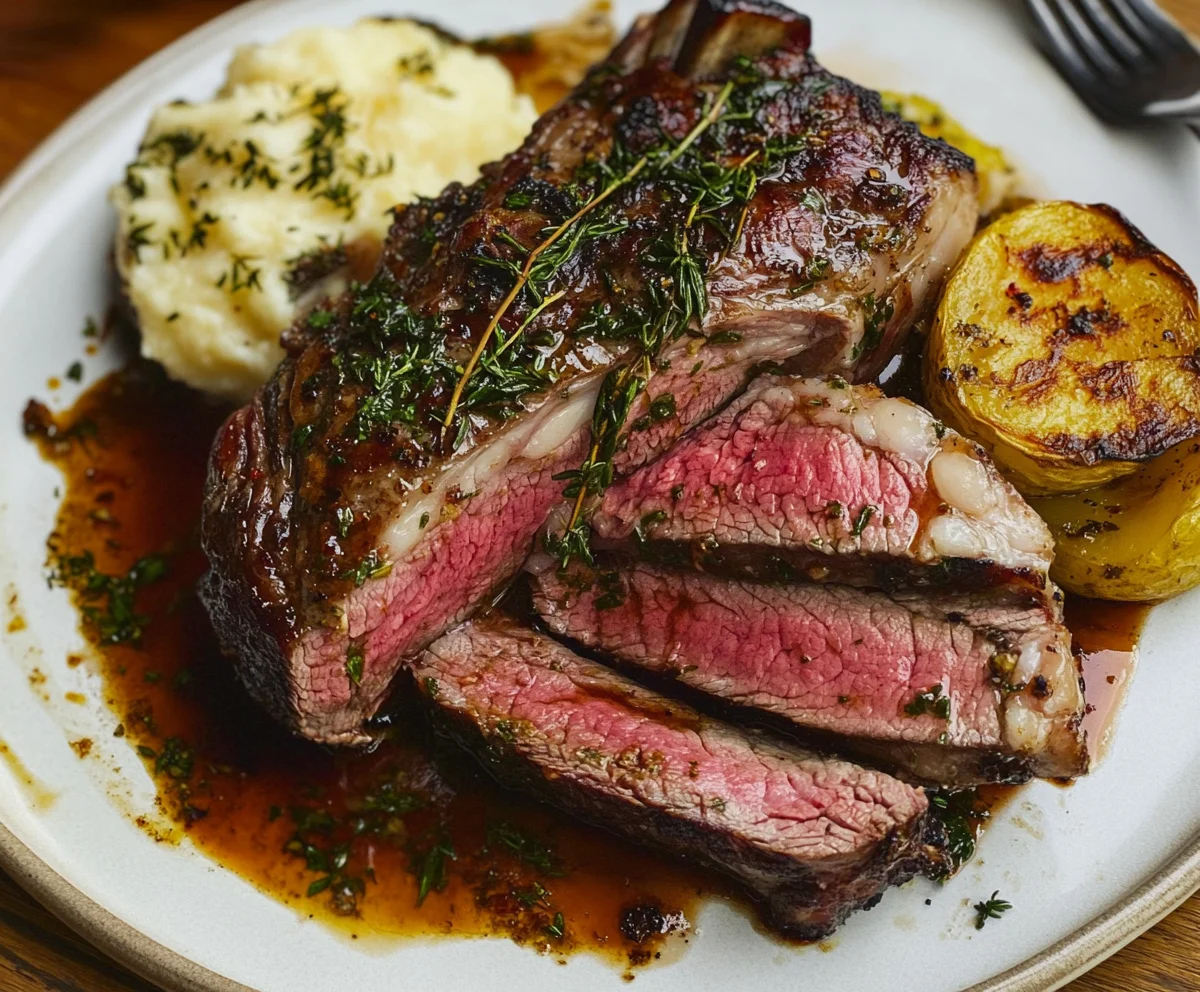There’s nothing quite like the satisfaction of serving up a juicy, tender ribeye roast recipe that’s been seasoned just right—it’s a dinner table showstopper that never fails to impress. Whether you’re crafting a showstopping centerpiece for a holiday feast or indulging in a luxurious weekend meal, a ribeye roast stands in a class of its own. Passed down through generations in my family, this roast has always been the star of our Sunday gatherings—crusted with herbs, slow-roasted to perfection, and served with laughter around the table.
In this comprehensive guide, I’ll walk you through everything you need to know: from selecting the ideal cut, seasoning secrets, to oven or grill cooking techniques, plus expert tips that ensure every slice melts in your mouth.
What is a Ribeye Roast?
A ribeye roast comes from the rib section of the cow, specifically between ribs six and twelve—it’s where you get that perfect balance of flavor and tenderness. This is the same area where ribeye steaks are carved, but when cooked as a whole, the roast offers deeper flavors and a tender texture that only comes from slow roasting.
Key features:
- Superior Marbling: Streaks of intramuscular fat enhance flavor and tenderness.
- Versatility is one of its best traits—you can roast it in the oven, throw it on the grill, smoke it low and slow, or cook it sous vide for precision-perfect results.
- Rich and full of character, the ribeye roast has a bold, beefy flavor that shines with just a touch of simple seasoning—it doesn’t need much to taste incredible.
Ribeye Roast vs. Prime Rib
These two are often confused, but here’s a quick comparison:
| Feature | Ribeye Roast | Prime Rib |
|---|---|---|
| Bone | Boneless or bone-in | Usually bone-in |
| Cooking Method | Roasting, grilling, smoking | Mostly oven roasted |
| Texture | Uniform and easy to slice | Slightly varied due to the bones |
While both are exceptional, the ribeye roast offers easier handling and carving, especially in the boneless form.

Choosing the Best Cut
1. Marbling: Look for visible, white fat lines across the meat.
2. Grade:
- Prime: Ultimate quality with rich marbling.
- Choice: Great for home cooking—affordable with good fat content.
- Select: Leaner and less tender.
3. Weight Guide:
- Boneless: ½ lb per person
- Bone-in: ¾ lb per person
👉 Pro Tip: Order from a butcher you trust, and don’t hesitate to ask for a French-trimmed bone-in ribeye for an elegant presentation.
Ingredients
Main Ingredients:
- 4-6 lb ribeye roast (bone-in or boneless)
- 2 tbsp kosher salt
- 1 tbsp freshly ground black pepper
- 1 tbsp garlic powder (or 4 minced cloves)
- 1 tbsp olive oil or softened butter
- 1 tbsp fresh rosemary, chopped
- 1 tbsp fresh thyme, chopped
Optional Enhancements:
- 1 tbsp Dijon mustard
- 1 tsp smoked paprika
- 1 tsp red pepper flakes
Essential Equipment
- Roasting pan with rack
- Instant-read meat thermometer
- Sharp carving knife
- Cutting board with grooves
- Aluminum foil
Step-by-Step: How to Make a Ribeye Roast Recipe
1. Dry Brine the Roast
Dry brining infuses the meat with flavor and helps it retain moisture.
Instructions:
- Pat roast dry.
- Rub with kosher salt.
- Place uncovered in the fridge for 12–24 hours.
2. Apply Seasoning Rub
Before cooking, mix olive oil with black pepper, garlic, herbs, and optional mustard or paprika. Massage it all over the roast.
3. Sear and Roast
Oven Method:
- Preheat to 450°F.
- Roast for 20 minutes to develop a crust.
- Lower temperature to 325°F.
- Roast until internal temp reaches desired doneness.

Grill Method:
- Sear over direct heat.
- Move to indirect heat zone.
- Cook slowly to temperature.
Doneness Guide
| Doneness | Temperature (°F) | Color |
|---|---|---|
| Rare | 120–125°F | Cool red center |
| Medium Rare | 130–135°F | Warm red center |
| Medium | 140–145°F | Slightly pink |
| Medium Well | 150–155°F | Minimal pink |
| Well Done | 160°F+ | Fully cooked |
👉 Take the roast out of the oven when it’s about 5°F below your target temperature. It’ll keep cooking as it rests, bringing it to the perfect doneness.
Resting & Carving
Allow the roast to rest, tented in foil, for at least 20-30 minutes. Slice against the grain for maximum tenderness. If you’re working with a bone-in roast, start by cutting along the bones to remove them, then slice the meat to your desired thickness.
Serving Suggestions
Sides That Shine:
- Garlic mashed potatoes
- Roasted Brussels sprouts
- Creamed spinach
- Yorkshire pudding
Wine Pairings:
- Cabernet Sauvignon: Full-bodied and bold
- Syrah/Shiraz: Peppery and rich
- Malbec: Balanced tannins
Beer Pairing: Go for a dark ale or stout.
Creative Variations
While the classic ribeye roast recipe is undeniably delicious, you can elevate it further by exploring exciting flavor variations that cater to different palates and occasions.
1. Garlic-Herb Butter Crust
Mix softened butter with minced garlic, rosemary, thyme, and a pinch of sea salt. Rub it generously over the roast before cooking. The butter melts into the meat, creating a luscious, herbaceous crust that pairs perfectly with roasted vegetables.
2. Espresso-Chili Crust
Mix together finely ground espresso, brown sugar, chili powder, and smoked paprika for a bold, flavorful rub with a touch of heat and a rich, smoky kick. This rub offers a rich, slightly smoky flavor with a touch of heat and bitterness that balances the fatty richness of the meat.
3. Balsamic and Dijon Glaze
Whisk together balsamic vinegar, Dijon mustard, and honey. Brush it over the roast in the last 15 minutes of cooking to form a tangy-sweet glaze that caramelizes beautifully, adding a glossy finish and complex flavor profile.
Storing & Reheating
- In the fridge, keep the slices in an airtight container—they’ll stay fresh for about 3 to 4 days.
- For longer storage, wrap the slices tightly in foil and pop them in the freezer—they’ll keep well for up to 3 months.
Reheat Tip: Use low heat in the oven (250°F) with foil to avoid drying out.
Common Mistakes to Avoid
❌ Overcooking: Always use a thermometer.
❌ Skipping the rest: The juices need time to redistribute.
❌ Don’t slice with the grain—always cut against the grain to keep each bite tender and easy to chew.
FAQs
Is ribeye roast the same as prime rib?
Not exactly. While they come from the same section, prime rib is usually bone-in and cooked with bones. A ribeye roast can also be boneless, which makes it a lot easier to slice and serve—no bones to work around, just pure, tender meat.
Should I sear before roasting?
Absolutely! Searing gives the roast a rich, caramelized crust and helps lock in all those tasty juices for a more flavorful bite.
Can I grill a ribeye roast?
Yes! Grill over indirect heat after searing. Add wood chips for smoky flavor.
Conclusion
Mastering the ribeye roast recipe is about understanding your ingredients, embracing simple techniques, and paying attention to detail. With a bit of patience and the right tools, you’ll create a show-stopping roast that guests will remember.
Whether served with a side of Yorkshire pudding, a robust red wine, or a holiday spread, this roast deserves a place at your table.

